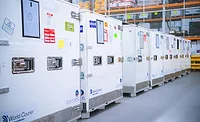IKEA Reduces Climate Footprint With Bio-Based Glues

Courtesy of IKEA.
IKEA announced it is switching from fossil-based to bio-based glues to reduce the climate footprint of board production. Today, 5% of the climate footprint of the total IKEA value chain is connected to the use of glue in board materials. With this change, the company’s goal is to reduce fossil-based glue use by 40% and greenhouse gas emissions from glue by 30% by 2030. Finding new glue solutions is one of the main approaches to reducing the IKEA climate footprint, and most glue consumption is used in board production.
“This is a big and important movement for IKEA, which we have been working to enable for more than 10 years,” said Venla Hemmilä, material and technology engineer at IKEA of Sweden. “This confirms the need for more glues with much lower climate footprints, and that small changes can have big impacts. We hope this will inspire others to follow.”
IKEA intends to have most board-producing factories in the IKEA supply chain using glues that have lower climate footprints by 2030. In Kazlu Ruda, Lithuania, the first IKEA Industry factory is now using a glue system made of technical starch from corn in large-scale production. The company says this results from 10 years of efforts to find alternatives to fossil-based glues. In parallel, multiple trials with other glue systems are being conducted.
”As glue in board materials stands for 5% of the climate footprint of the IKEA value chain, this makes a big impact and a key step towards contributing to limiting global warming to 1.5 °C,” said Andreas Rangel Ahrens, head of climate at Inter IKEA Group. “Together with increasing recycled wood use and striving towards 100% renewable energy in production, this is a milestone in our journey of making our wood-based products more sustainable.”
For more information, visit: https://about.ikea.com/.
Looking for a reprint of this article?
From high-res PDFs to custom plaques, order your copy today!






